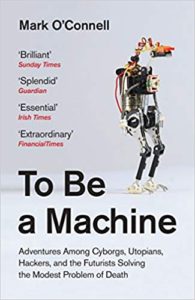Jeanette Winterson “Frankisstein: A Love Story”
Nothing — said Professor Stein — it tells us a great deal about Saudi Arabia.
Professor Stein, as you know, the Hanson robot, Sophia was awarded citizenship of Saudi Arabia in 2017. She has more rights than any Saudi woman. What does this tell us about aritifical intelligence?
…
Will women be the first casualties of obsolescence in your brave new world?
On the contrary, said Professor Stein, AI need not replicate outmoded gender prejudices. If there is no biological male or female, then –
…
She says, Professor Stein, you are the acceptable face of AI, but in fact the race to create what you call true artificial intelligence is a race run by autistic-spectrum white boys with poor emotional intelligence and frat-dorm social skills. In what way will their brave new world be gender neutral — or anything neutral?
…
Even if, even if the first superintelligence is the worst possible iteration of what you might call the white male autistic default programme, the first upgrade by the intelligence itself will begin to correct such errors. And why? Because we humans will only programme the future once. After that, the intelligence we create will manage itself.
And us.
Jeanette Winterson’s Frankisstein: A Love Story is a modern retelling of Mary Shelley’s Frankstein. The story begins at the Villa Diodati (1816) on the shores of Lake Geneva a well-known scene for it is the one in which 19-year-old Mary Shelley conceived of her novel Frankenstein. Two hundred years on Frankisstein is about Ry, short for Mary, Shelley, a transgender medical professional self-described as “hybrid”, meeting Victor Stein, a celebrated professor of artificial intelligence, during a visit to a cryonics facility in the Arizona desert — a setting that exists in reality called Alcor Life Extension Foundation but is never mentioned by name in the novel. there is a professional and a sexual attraction between the two scientists.
The novel makes this overarching connection between Mary Shelley’s Frankenstein with modern science advancing sufficiently to enable those who wish to, to have a sex change to the application of AI. Frankisstein starts off really very well but after a while fizzles out particularly when The Romantics are clumsily described. Byron and Polidori come away nowhere like the characters one has known them to be and the Shelleys too are an odd couple. The descriptions of Mary Shelley come across as too modern or more as if a twenty-first century interpretation has been imposed upon her character.
Nevertheless artifical intelligence is gaining significance by leaps and bounds every single day. Real life is rapidly morphing into something out of a science fiction story. AI research is helping these initiatives in many, many ways. Some more apparent than others but AI is most certainly here to stay. “The world is at the start of something new,” Winterson writes, “what will happen … has begun.” It is a brave new world but with its many challenges. The crux of Frankisstein is well articulated in the conversation quoted above. It is an unnerving thought when expressed so clearly to have a new world created by a handful of AI scientists propogating their own biases — knowingly or unknowingly, we will never know!
Jeanette Winterson explores her pet themes in Frankisstein of gender, sexuality, and individual freedom. These issues are gaining importance in a technologically driven world. It is rapidly transforming the reality as we know it into something that is increasingly unpredictable as the evergrowing and controlling presence of computers increase in the human world.
Frankisstein is a curious novel that some may find readable and others a tad alarming. But it is a novel meant to be read.
7 June 2019

